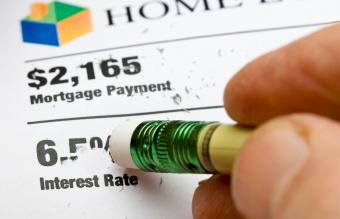
Obtaining a mortgage loan to purchase or refinance a home requires some work on the part of the borrower. You have to gather up some specific documents to prepare for your meeting with the mortgage lender so you have the financial information the lender needs to help guide you. The lender uses these financial statements to tell you whether or not you can receive approval for the loan and how much of a mortgage loan you can qualify to receive.
Financial Statements
In addition to the purchase and sale agreement for the home, the majority of the documents you have to supply the lender with are financial documents. Overall, the lender uses these statements to determine your financial situation, such as how many assets you have (cash, real estate, vehicles) and how much debt you carry (personal loans, vehicle loans, students loans, credit cards). These are statements you can take along with you to the meeting so you have the information in front of you when the lender asks for it.
Income Statements
Most lenders require applicants to submit the two most recent pay stubs or W-2 forms. For self-employed individuals or freelancers, 1099 forms may be required by the lender. The pay stub details your pay along with any deductions that come out of your pay for health insurance, Social Security and FICA.
- W-2 forms are tax forms your employer has to provide to you on an annual basis. You use these forms when preparing and filing your income tax forms. W-2s show the total gross income for the year from your employment and the total deductions taken out of your pay for the year.
- A 1099 is similar to a W-2 form, but is the tax form that a freelancer or self-employed individual receives from clients. The 1099 shows the total gross income for the year from the client and any deductions taken out of the payment for the year. Each client provides a 1099 form for the work performed by the freelancer or self-employed individual.
Pay stubs and W-2 forms verify to the lender what your gross monthly income is. They use your gross monthly income figure to determine how much of a mortgage loan you can qualify for according to their qualification guidelines. If you already know the mortgage amount you need, lenders can use the income to determine if you qualify for the amount you want to apply to receive.
Tax Returns
You also want to take along copies of your tax returns for the past two years. You need the entire tax form including any schedules that you file. Tax forms show all of your income and deductions on a line by line basis.
Lenders use these forms to verify that the income from employment showing on the income statements mentioned above match what is being reported to the IRS. They also use tax returns to verify any unreimbursed expenses you have from employment, losses from self-employment or any signs of fraud.
Bank and Brokerage Account Statements
Take along copies of bank and brokerage account statements for the past two months. This includes your checking and savings accounts, as well as investment accounts, including IRAs and 401ks or other retirement accounts. These statements show all of your cash available to you, as well as the types of assets you have in the form of investments, such as stocks, bonds and mutual funds.
The lender uses these statements to verify your asset amount and the amount of cash you are able to access. Typically, lenders prefer that you have cash or liquid assets (convertible to cash) to cover two to three months of taxes and insurance on the property. Lenders also use these statements to verify that you have cash on hand to cover any closing costs you are responsible for paying on the purchase or refinance of the property.
Loan Statements
If you have student loans, personal loans or vehicle loans, the lender may require at least two months of these statements. Loan statements show your existing balance, the monthly payment and the interest rate for the loan. Lenders use the numbers of the statement to verify the debts that show on your credit report.
If a loan shows on your credit report that you don't list on your mortgage application or provide statements for, the lender can question you on what the loan is before qualifying or denying you for the loan. Lenders also use the minimum monthly payments due on each of these loans to calculate your debt-to-income ratio, which is a calculation that turns your total amount of debts into a percentage of your total income.
Lenders like to see that you don't have too many debts when compared to your income so that you can qualify to carry the mortgage loan. The specific debt-to-income ratio can vary from lender to lender.
Credit Card Statements
The last two to three months of your credit card statements can also be requested by the lender after reviewing your credit report. Similar to any types of loans you have, lenders use the statements to compare the credit cards you list on your application to those showing on your credit report. Lenders also use the balance and minimum monthly payments due on the credit cards to calculate the debt-to-income ratio.
Profit and Loss Statement
Self-employed individuals may also have to show a profit and loss statement for the current year. A profit and loss statement shows the income and the debts that the business has year to date. This statement illustrates to the lender what the income is for the self-employed individual. Some lenders require self-employed individuals to supply the tax returns for the company for the last two years.
Similar to the need to provide personal tax returns, providing business tax returns and a recent profit and loss statement allow lenders to verify income, deductions and that fraud is not an issue.
Miscellaneous Documents
Personal financial situations differ from person to person. If you have specific financial situations, the lender can require other documents from you.
Rental Income
If you own rental property, you have to show the income on your tax returns. In addition to the tax returns, lenders can require you to show the canceled checks or payment deposits from the tenant. If you intend to rent out the property you are currently living in, the lender can require you to show a lease agreement with a tenant for at least a one year period.
Rental Checks
If you rent the home or apartment where you live now, lenders can also ask for verification of rent payments. If it clearly shows cleared checks to a landlord or apartment complex on your bank statements, this can be enough proof. They can ask for up to a year's worth or more, however. If bank statements do not show proof, then copies of canceled checks can be requested by the lender.
Child Support or Alimony Documents
For individuals that receive child support or alimony payments, proof of this can be required if you are using this as income to help qualify for the mortgage. If you are the person responsible for paying the child support or alimony payments, proof of the payment amount may be required because it is included as one of the debts in the debt-to-income ratio for qualification purposes.
Bankruptcy Discharge Paperwork
If a bankruptcy is showing on your credit report, bring along your bankruptcy discharge paperwork. A bankruptcy can mean the denial of a mortgage loan. Showing the lender that the bankruptcy has been discharged can make the difference in whether or not you qualify for the loan.
Painting a Financial Picture
Lenders use your financial statements to paint a financial picture of your personal situation. Once the lender has all of the information they need to view your financial situation, they can qualify or deny you for the mortgage loan.







